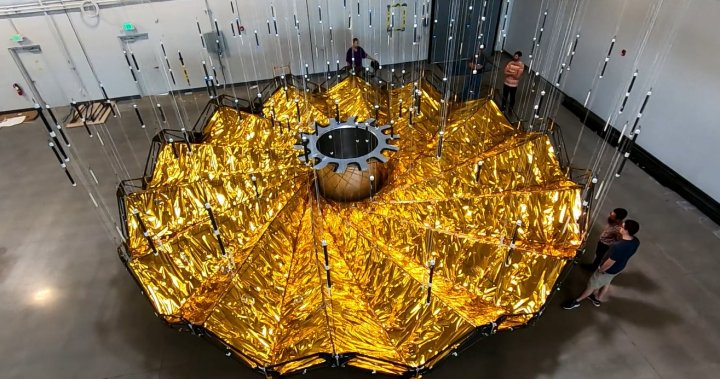How origami can help in space exploration | Globalnews.ca

It’s an ancient form of art, but now origami is providing modern solutions in the fields of space, engineering, mathematics and medicine.
For one Canadian aerospace engineer, origami and its ability to turn something very large into something very small is helping to unlock secrets about the universe.
According to NASA, there are a couple hundred billion stars in the galaxy. Here on earth, we can only see a few thousand of the nearest ones. Even though we marvel at their existence, for those in space exploration, the glare from the stars could hinder future discoveries.
“When you’re trying to look for earth-like planets next to sun-like stars, … the reflected light from the planets is about 10 billion times fainter in the light of the star,” says Manan Arya, now an assistant professor at Stanford University.
Arya has been working for years on a galactic puzzle: how to block starlight in a universe that could contain up to one septillion stars? One solution, he says, lies in an ancient form of art: folding paper.
“The reason we need origami for space applications is because we want to launch structures in space that are just amazingly big,” says Arya.
He says engineers need to be able to fold these structures to fit neatly within rockets and “then unfold when they get to space.”
Aerospace engineering professor, Manan Arya, speaks with Global News about the role of origami in space.
Jory Lyons/Global News
Manan calls it the “suitcase problem.” But instead of packing clothing, it’s about how much expandable technology you can cram into a small space capsule.
The allure of space first captured Arya when he was a child. Born and raised in New Delhi, India, he dreamt of becoming an astronaut.
As he got older, he realized that profession might not be for him.
“I like to sit and think for a long time before I take action. I’m terribly not useful in emergencies,” he told Global News.
Arya would go on to develop another dream: working on projects to support NASA and space exploration.
It would be years before that goal would be realized.
In 2003, Arya and his family moved to Canada, where he attended high school. Then, he would go on to do his undergraduate engineering degree at the University of Toronto. It was at U of T that he became captivated with studying structures.
“I became fascinated with these kinds of spacecraft called solar sails … and that’s what led me to origami,” he says.
Traditionally, origami is the folding of paper into abstract or realistic creations. The Japanese art dates back thousands of years. Now, its principles can be found in many different fields, including aerospace.
“It was really in the ’60s and ’70s when mathematicians and academics got interested in the art of origami,” Arya tells The New Reality. “Since that time, they’ve developed this fantastic toolset of ideas … that were available to me that I could just pick up and run with.”
Origami-inspired starshade prototype in a test facility.
Credit: NASA/JPL-Caltech/Tendeg
Arya brought his fascination with origami to the California Institute of Technology, also known as Caltech.
Caltech manages NASA’s Jet Propulsion Laboratory (JPL). After graduating, he got a job at JPL.
“I had dreams that maybe it would be fantastic if I could go to the epicentre, which is NASA, and maybe contribute there. I never actually thought it would happen, but it kind of did,” he says.
While at JPL he started working on starshade, a lightweight mechanism that when deployed would unravel into a flat disk with petals resembling a sunflower. It’s meant to block out a star’s light, allowing the fainter exoplanets to be seen and studied.
Flying with a space telescope, the starshade would use thrusters to put itself into position allowing the telescope to capture images from fainter objects near the star.
Flower power: As seen in this animation, flying with a space telescope – the starshade would use thrusters to put itself in a position to block a star and allow the telescope to capture images.
NASA/JPL-Caltech
It’s roughly the size of a baseball diamond when totally stretched out. But in order to launch, it needs to fit inside a rocket that is only about five metres in diameter. That’s where the origami comes in.
It’s “a fantastic application of origami engineering in space,” Arya says.
NASA has had success using origami already. One example is the powerful James Webb’s telescope’s main mirror and sunshield. It had to be folded up so it could be launched into space, then unfolded when it was finally in position.
And the pictures James Webb is sending back can only be inspiration for starshade.
Arya said starshade is not an official NASA mission. It’s a technology that’s in development, so that engineers have “it in our back packets for future missions.”
Until then, Arya has expanded his interests with origami. While his primary focus is spacecraft structures, he is also looking at applying the same techniques to robotics and recently he started research on biomedical devices.
Although the long-term impact of his work is still unfolding, Arya’s hope is that one day it will help in space innovation.
“Parts of me wish that my work would have more immediate impact,” he says.
“At the same time, I’m satisfied with the idea that I’m doing work that is foundational for the next generation of technologies.”
— with files from Eric Sorensen
For all the latest Technology News Click Here

